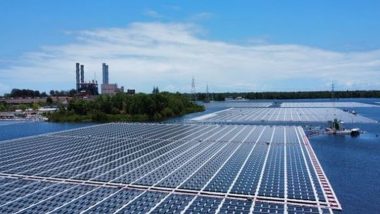Lucknow, January 5: Ayodhya is taking strides towards clean energy solutions to address its energy requirements. Currently, the work of development and operation of a solar power plant capable of generating 40 MW of electricity in Majha Rampur Halwara village of Navya Ayodhya has reached the final stage. In line with Chief Minister Yogi Adityanath's vision to harness solar energy for power generation, a solar power plant is currently under development and operation, spanning 165 acres for Rs 200 crore.
It's worth highlighting that Vision 2047 places significant emphasis on solar energy within Ayodhya's comprehensive development plan. Consequently, the establishment of this solar power plant is poised to play a pivotal role in steering Ayodhya towards becoming a city powered by solar energy. Last Sunset of 2023 Video From Ayodhya: Watch Beautiful Visuals of Ram Mandir in Uttar Pradesh.
For the establishment of this plant, under the guidance of CM Yogi, the district administration has provided land on a 30-year lease to the Uttar Pradesh New and Renewable Energy Development Agency (UPNEDA) at the rate of Rs 1 per acre per year. UPNEDA, in turn, has engaged NTPC Green Energy Limited to operate the plant on this land.
For the development and operation of the plant, Jackson Solar, a notable solar panel producer and a prominent player in the solar energy sector in the country, has been contracted by NTPC through a Power Purchase Agreement (PPA). Union Cabinet Approves Naming Ayodhya Airport As Maharishi Valmiki International Airport, Ayodhyadham.
Ratan Singh, Head of Project and Additional General Manager of NTPC Green Energy Limited, informed that the total capacity of this solar power plant will be 40 MW of power generation and that it will produce 8.65 crore units of power per year.
The total cost of this project is Rs 200 crore and the work of developing the plant located on 165 acres has been entrusted to Jackson Solar, which is a leader among the Indian companies working in the solar energy sector. A total of 104580 solar panels with a power output of 550 and 555 watts are installed in this plant. The scheduled inauguration of the plant is set for January 22, initially operating at a capacity of 10 MW power generation.
Following the inauguration, the plant is expected to quickly scale up to its full capacity. When operated at full capacity, this plant will be able to meet 10 percent of the total electricity consumption of Ayodhya. The electrical energy generated from the plant will be transmitted to the Darshannagar sub-station through a 13233 KV overhead power line.
At present, a workforce of about 300 people has been deployed at the plant for the ongoing work. Once completed, the plant will require only 15-20 people to operate, with technical and handling staff being the most important. UPNEDA Project Officer Praveen Nath Pandey said that apart from realising CM Yogi's grand vision of Ayodhya, this project will also be economical and environmentally friendly.
According to him, instead of power generation from coal, power generation here will help prevent 47,000 thousand tonnes of carbon dioxide emissions every year. This translates into a significant impact, preventing emissions equivalent to the carbon dioxide absorption capacity of 17 lakh trees.
The initiative is poised to become a significant milestone in Ayodhya's journey to establish itself as a model solar city. Furthermore, it will set the stage for transforming Ayodhya into a city powered by solar energy.
(This is an unedited and auto-generated story from Syndicated News feed, LatestLY Staff may not have modified or edited the content body)













 Quickly
Quickly





















